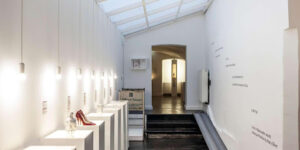By Noah Nobbe

Figure 1: A shot of the interior of the Museum of Broken Relationships in Zagreb, Croatia from their website. While our virtual walkthrough was done late at night right before the museum closed, we were still able to gain an appreciation of the exhibits through Olinka and Dražen’s narration.
As a second-year public history master’s degree student, I have had many classes discussing museums and public history institutions and their role in public-facing, informal education. But before now, I had not had many chances to put any of that teaching to work, explore museum studies theory, or consider how to use it in actual program design. But with the announcement of our collaboration with the Museum of Broken Relationships (MBR), I was happy to engage in readings and class discussion that refreshed my memory about museum education, expanded my thinking, and set the stage for the semester.
In one of our primary readings this week, George E. Hein’s (2006) essay on museum education looks at the origins of the field. He writes that education has always been an important role for museums, even though the subfield of museum education was not given its due until relatively recently. As one of the leading forces in informal learning, museums and education go hand in hand, even if it took a while for “museum education” to gain prominence and respect.
Hein’s discussion of museum education then led into a discussion of its theoretical foundations, specifically education theory. Of all the theories he presented, Hein voiced his support for constructivism. This theory, in practice, is composed of active learning and knowledge constructed by the learner. Within a museum, where a visit is voluntary and often self-led, this constructivist style is a great way to help visitors piece together the answers and takeaways of exhibits and programs on their own, and not be confined to someone else’s idea of the theme.
This constructivism theory also aligns with the style of the international Museum of Broken Relationships, which we were able to experience this week live from Croatia through a Zoom meeting with museum co-founders Olinka Vištica and Dražen Grubišić. They were gracious enough to meet with us, despite the fact our class started at 9 p.m. their time and lasted a good while after the museum closed at 10. While we had read about their museum before meeting them, hearing their personal testimonies about the museum’s origins and what it means to them was truly inspiring.
Based on how they described their museum and mission, they very much follow the constructivism theory of learning. The experience of walking through the displayed artifacts and attached stories in the museum is absolutely active. As visitors view the artifacts, they have the option to investigate further and read the story behind the object, written by the donor, if they wish. As they read the stories, they can relate the experience shared by the donor to their own history of broken relationships, thereby constructing their own takeaways from the museum. No two visitors will come away with exactly the same experience, yet patterns of meaning may emerge. This is the epitome of constructivist museums.
Olinka and Dražen made another point that truly impressed me: their commitment to a diversity of stories. When I first heard about the Museum of Broken Relationships, I assumed its entire focus was on romantic relationships, specifically those of young people. However, this was absolutely not the case. They clearly value an inclusive definition of “relationship,” which could mean family, friends, and more. This not only increases the quantity of donations but the quality as well. And as the quality improves, so does the possibility for impactful and effective museum education.
As our Museum Education class looks to create our own educational content and programs to accompany the MBR exhibition in Indianapolis next year, this meeting with Olinka and Dražen was both a blessing and a curse. On one hand, they are an inspiration to all of us, and we cannot believe they have entrusted us with their museum’s name and reputation! On the other hand, being handed these reins is terrifying, especially to those of us with little to no experience in museum education. However, after some thought, I realized that handing over the reins was exactly what the Museum of Broken Relationships has been doing since its inception: providing a platform for others to actively participate. At the end of the day, that should be our focus throughout this project. We are creating an environment for all visitors to have the opportunity to construct their own experience.
For this to work, we have to embrace the meaning of museum educators: to be facilitators. We can plan collaborations or show off rare artifacts and art, but unfortunately, not every mind will be captivated, and not every curiosity will be quelled. That is where museum education and school education overlap. We can lesson plan all we want, but in the end, the audience will take their own personal journey. The best we can do is give them a welcome mat.
Noah Nobbe is a second-year graduate student in public history at IUPUI.
References
Hein, George E. 2006. “Museum Education.” In A Companion to Museum Studies edited by Sharon Macdonald, 340-352. Hoboken: Wiley. https://revistamito.com/files/downloads/museumedblackwellhein.pdf.

